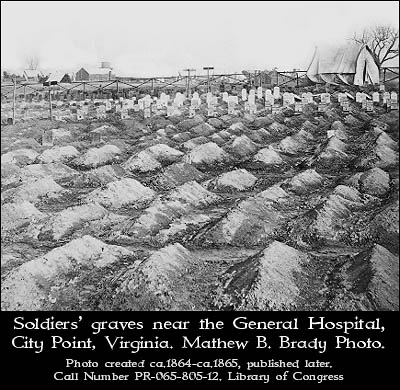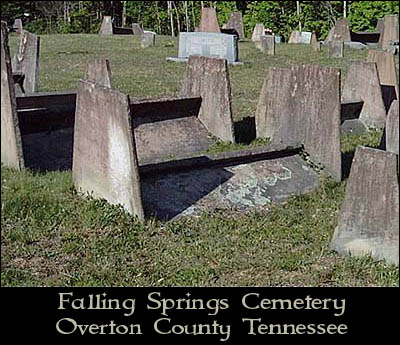


Triangular Monuments
In the Civil War photograph above, we see the fresh graves in the foreground that have no visible markers
and no monuments. We also see the form of triangular mounds. When a grave is dug, the earth is set aside, the
coffin (or perhaps a shroud wrapped body) is placed in the grave, then the earth is replaced on top of the coffin.
Since the volume of the coffin has displaced some earth that will no longer fit in the grave, the earth is placed
above ground level.
Over time, the coffin decomposes, as does the body,1 and with
the advent of rain, the earth slowly
compacts downward. The triangular mound may totally disappear leaving a shallow depression.
However, there was a time when it was believed that mounded earth over the grave would deter water from entering
the grave. The placement of two simple slabs over the mound would even further deter the water from seeping through to the coffin.
(We note that the triangular shape also appeared in a few early Virginia coffins.)

Image courtesy John Mullinix. See more at his
Website under
Genealogy
Links.
Tent grave monuments may be constructed with two slabs, either of native stone or often of concrete.
Some will have headstones, and possibly footstones. Some will have neither. Tent grave monuments may also be
constructed of unfinished stone to precisely cut ashlars. Even the size of the stones will vary, and the large
ashlars will have a step effect.
More Triangular Monument Images
 Lavender Family Cemetery, Morgan County
Tennessee (150k)
Lavender Family Cemetery, Morgan County
Tennessee (150k)
 Mt. Gilead Cemetery, White County
Tennessee (150k)
Mt. Gilead Cemetery, White County
Tennessee (150k)
 Old Baptist Graveyard, Pelham, Grundy County
Tennessee, (View I), (View II)
Old Baptist Graveyard, Pelham, Grundy County
Tennessee, (View I), (View II)
 Warren Cemetery, Pelham, Grundy County
Tennessee, (View I), (View II)
Warren Cemetery, Pelham, Grundy County
Tennessee, (View I), (View II)
Note:
1.“An unembalmed adult body buried six-feet deep in ordinary soil without
a coffin normally
takes ten to twelve years to decompose down to a bony skeleton; a child’s body takes about half that
time.”
Iserson, Kenneth V., M.D. Death to Dust, Galen Press Ltd. 1974, p. 314.
Return to:
Project Home Page
Page © 2002 Fred Smoot




Lavender Family Cemetery, Morgan County Tennessee (150k)
Mt. Gilead Cemetery, White County Tennessee (150k)
Old Baptist Graveyard, Pelham, Grundy County Tennessee, (View I), (View II)
Warren Cemetery, Pelham, Grundy County Tennessee, (View I), (View II)